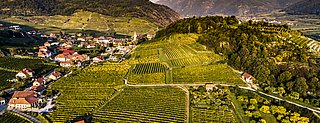
Burgberg
Facts:
- Town:
- Spitz
- Subsites:
- Schlossgarten
- Size in ha:
- 12,82
- Altitude in m:
- 228 - 288
- Aspect:
- NW
- Average Slope in %:
- 16
- Max. Slope in %:
- 65
- Insolation in hours per year:
- 2214
- Terraced vineyard:
- Partially
- Distance to Danube in m:
- 372
- Labour required in h:
- 5.800
- First documentary evidence:
- 1257
Description
Burgberg refers to the local mountain of Spitz, the Hausberg, around which the town was established. The prominent front face of the mountain can be seen from a great distance and is known as the “1000-Eimerberg" (thousand-bucket mountain). The wines from the rear face of the mountain are given this designation, as are those from the vineyards in the centre of town. The heavy and nutrient-rich soils of the Burgberg represent a significant contrast to the steep and barren slopes of the 1000-Eimerberg.
Soil Profile Burgberg
The 1000-Eimerberg and the Burgberg, while two sides of one coin, could not be more different. The idyllic location of the Burgberg vineyard represents the side of the 1000-Eimerberg facing away from the Danube. Lamellic layer sequences composed of calcareous, sandy and marly layers offer a contrast, both in terms of geology and pedology as well as visually, to the gneiss that otherwise dominates in the Wachau region. They were deposited in an ocean 15-16 million years ago. On erosion-protected sites, their remains have been conserved until today to form the subsoil of the vineyards in local areas. The heavy and calcareous soils are in sharp contrast to the neighbouring light soils that formed from weathered gneiss material. Here also, Grüner Veltliner achieves excellent results.




